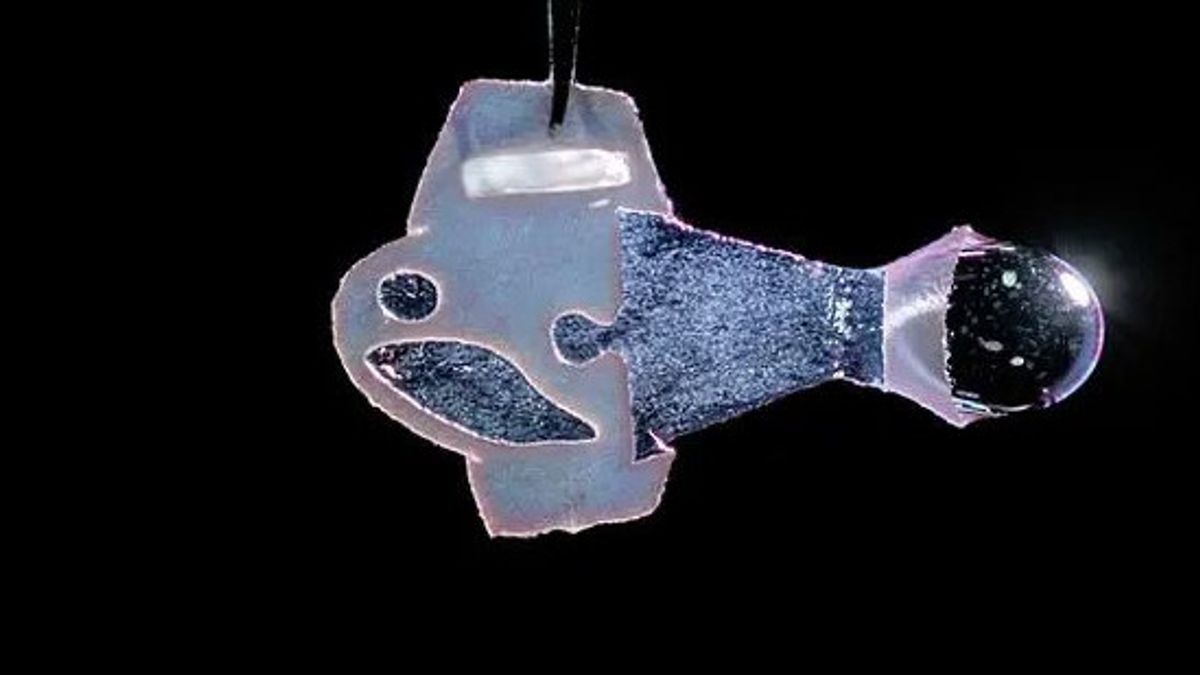JAKARTA - A robofish built from human heart cells, which lives and swims like fish, could pave the way for future artificial hearts.
This robofish was created by researchers at Harvard University, a 'biohybrid' that recreates the muscular contractions of the human heart pumping to propel its tail fin from side to side.
It's under half an inch long, made of plastic fins and a paper spine, but on either side are two strips of cardiac muscle cells that live by contracting.
The device, which can be mistaken for a real fish when viewed with the naked eye, is inspired by the shape and swimming movements of zebrafish.
In addition to its applications in the field of robotics, scientists believe that their creation will mark a step towards building a man-made heart.
"Our ultimate goal is to build an artificial heart to replace a defective heart in a child," said study author Kit Parker at Harvard's John A. Paulson School of Engineering and Applied Sciences.
"Most of the work in building cardiac or cardiac tissue, including some of the work we have done, is focused on replicating anatomical features or replicating simple heartbeats in engineered tissue," he said.
“But here, we draw design inspiration from cardiac biophysics, which is more difficult to do. Now, instead of using cardiac imaging as a blueprint, we identified the key biophysical principles that make the heart work, and used them as design criteria, and replicated them in a system, living and swimming fish, where it is much easier to find them. See if we make it," Parker said.
The team built their biohybrid fish from cardiomyocytes – the cells responsible for generating contractile forces in the heart – derived from human stem cells.
Stem cells are specialized human cells that have the ability to develop into special types of cells in the body, from muscle cells to brain cells.
Unlike previous sets, this biohybrid fish has two layers of muscle cells, one on each side of the caudal fin. When one side of a muscle cell contracts, it causes the cells on the other side to stretch.
This stretch triggers a protein that prompts them to contract, which triggers another stretch, and so on.
This closed-loop system, which requires no human intervention, was able to propel the fish for more than 100 days, according to the researchers.
Impressively, as cardiomyocytes matured, fish muscle contraction amplitude, maximum swimming speed, and muscle coordination all increased in the first month.
According to the team's report, the biohybrid fish eventually achieved swimming speed and efficacy similar to that of zebrafish in the wild,
Artificial hearts grown from stem cells can also help people with arrhythmias — heart rhythm disorders that make it beat too slowly, too fast, or in an irregular way.
"By harnessing the heart's mechano-electrical signals between the two muscle layers, we are recreating a cycle in which each contraction is generated automatically in response to stretching on the opposite side," said co-author Keel Yong Lee at Harvard. "The results highlight the role of feedback mechanisms in pumping muscles such as the heart."
In the future, the team aims to build more complex biohybrid devices from human heart cells, which mimic the human heart more closely than ever before.
"I can build a heart model from Play-Doh, that doesn't mean I can build a heart," Parker said. "That's the challenge. That's where we work."
In 2012, Parker's Disease Biophysics Group used heart muscle cells from mice to create a jellyfish-like biohybrid pump. Four years later, researchers developed an artificial stingray that was also derived from mouse heart muscle cells.
The English, Chinese, Japanese, Arabic, and French versions are automatically generated by the AI. So there may still be inaccuracies in translating, please always see Indonesian as our main language. (system supported by DigitalSiber.id)













